Insulin Know How
Hypoglycemia
Cause and
Treatment
Photos
Mine
My
Sibs
Other
Sugarcats
United Sugarcats
of the World
Stupid Feline
Diabetes
Practitioner
Award
Good Vet-Bad Vet
Which Is Yours?
Home
Insulin Know How
Hypoglycemia
Cause and
Treatment
Photos
Mine
My
Sibs
Other
Sugarcats
United Sugarcats
of the World
Stupid Feline
Diabetes
Practitioner
Award
Good Vet-Bad Vet
Which Is Yours?
Home
Insulin Know How
Hypoglycemia
Cause and
Treatment
Photos
Mine
My
Sibs
Other
Sugarcats
United Sugarcats
of the World
Stupid Feline
Diabetes
Practitioner
Award
Good Vet-Bad Vet
Which Is Yours?
Home
Insulin Know How
Hypoglycemia
Cause and
Treatment
Photos
Mine
My
Sibs
Other
Sugarcats
United Sugarcats
of the World
Stupid Feline
Diabetes
Practitioner
Award
Good Vet-Bad Vet
Which Is Yours?
Insulin Know How
or
Everything you never thought you'd need to know about Insulin
Insulin is a hormone, and therefore, a protein. Insulin is secreted by groups of cells within the pancreas called islet cells. The pancreas is an organ that sits behind the stomach and has many functions in addition to insulin production. The pancreas also produces digestive enzymes and other hormones (such as Glucagon). Carbohydrates (or sugars) are absorbed from the intestines into the bloodstream after a meal. Insulin is then secreted by the pancreas in response to this detected increase in blood sugar. Most cells of the body have insulin receptors which bind the insulin which is in the circulation. When a cell has insulin attached to its surface, the cell activates other receptors designed to absorb glucose (sugar) from the blood stream into the inside of the cell.Insulin is measured in units. The unit is a measure of weight: 24 units = 1 mg. Don't confuse this with the measurement of insulin doses. What I am referring to here is that 24 units of pure insulin weighs 1 mg. By "pure" I mean insulin which is not mixed with a liquid to facility it's injection into the body.
When you purchase insulin for your diabetic cat, it is mixed with a liquid to create a suspension, note - insulin mixtures are not a solution of insulin in a solvent. Insulin does not readily dissolve in the liquids in which is is distributed; in some mixtures the insulin does not dissolve at all.. Hence the need to micx insulin before withdrawing a dose from the vial. More about this later in the page.
Types of Insulin
Insulin is either beef, pork, beef and pork combined, or human. This is the species of the insulin and is indicated on the label of the insulin vial.Human insulin is genetically engineered from E. coli bacteria ('Humulin," made by the Eli Lilly Company, the most common type prescribed for diabetic cats).
Human insulin now accounts for the majority of all the insulin used. It has pretty much replaced all animal insulins.
Since the Beef insulin was the closes thing to a cat's insulin, many cat's were being given beef insulin.
Because the use of non human insulin by human diabetes has decreased drastically since the advent of genetically engineered insulin, many brands of beef and pork insulins that were used for cats are no longer available.
Types of insulin include Regular, NPH, Lente, Ultralente. There is another type of insulin called PZI which is used by some cat owners with good results. The types of PZI insulins used for cats are Beef or Pork insulins. More information on that later.
The important characteristics of each type of insulin are:
Many factors such as species, injection site, and exercise level affect the onset, peak, and duration of insulin.When it starts to work (onset) When it works hardest (peak activity) How long it lasts (duration) Regular insulin is fast acting and lasts a short time in the body. It is used before meals to control the post-meal rise in blood sugar, and to lower blood sugar quickly when an immediate correction is needed.
NPH insulin contains added protamine for an intermediate-acting effect. NPH insulin provides a basal amount of insulin. Two injections a day are usually prescribed.
Lente insulin contains added zinc, which gives it an intermediate-acting effect similar to NPH. Lente insulin also provides a basal amount of insulin. Two injections a day are usually prescribed.
Ultralente insulin contains a lot of added zinc to give it the longest-acting effect. Note that Humulin Ultralente has a shorter peak and duration than beef Ultralente. Ultralente insulin provides the steadiest basal amount of insulin. One injection a day is used in combination with Regular insulin before meals.
This table summarizes the different kinds of human insulins and how they act. These exact numbers are for the "Humulin" brand of human insulin.
Humulin Insulin Activity (in humans)
| Type | Onset | Peaks | Duration |
|---|---|---|---|
| Regular
NPH Lente Ultralente |
30-60 minutes
2-4 hours 3-4 hours 6-10 hours |
2-3 hours
4-10 hours 4-12 hours minimal peaking |
4-6 hours
14-18 hours 16-20 hours 20-30 hours |
Care of Insulin
Eli Lilly, maker of Humulin insulins, states that an unopened vial of insulin can be stored at room temperature (59° - 86° F) for up to 1 month. If refrigerated (36° - 46° F) it can be stored until the expiration date printed on the box. (source: Eli Lilly FAQ, Question 4 )Loading an Insulin SyringeEli Lilly also states that an opened vial can be stored for 4 weeks either refrigerated or at room temperature (source: Eli Lilly FAQ, Question 4 )
The Eli Lilly FAQ also states:
"At elevated temperatures, insulin has been shown to lose potency. This loss of potency is accelerated as the temperature increases. For this reason and for reasons of consistent temperature exposure, it is recommended that refrigeration be employed whenever possible. "Other sources say that an open vial can be stored for up to 3 months if refrigerated and up to 1 month if at room temperature. (example source: Joslin Diabetes Center" Hints for the use of insulin)"Care should be taken not to use insulins which have changed in appearance
due to heat exposure or freezing. Always check the appearance of your vial of insulin before using, and if you note anything unusual in the appearance of your insulin or notice your insulin requirements changing markedly, consult your doctor."The point of disagreement here is as to the length of time an opened vial can be stored under refrigeration - 4 weeks or 3 months.
My personal experience has shown that insulin kept under refrigeration for as long as 9 weeks remains effective. This is longest that I've kept a vial before getting a new one.
Do not freeze insulin.
Rough handling of insulin can break the bonds between the two amino acid chins in the molecule and render it useless. Do not shake a vial of insulin to mix it. Instead roll it between your palms several ties and gently rock it top to bottom a few times.
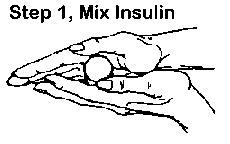
Mix Insulin by rolling vial between palms. Do not shake the vial or roll to vigorously, the Insulin molecule has two chains of amino acids joined by a weak bond which can be broken if the insulin is treated roughly. Once this bond is broken, the insulin will be totally ineffective. |
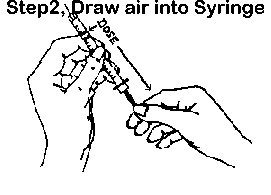
Draw air into the syringe in the same amount as the dose of insulin to be given plus one or two extra units. |
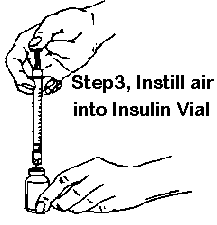
Inset needle into vial's rubber seal and slowly push in the plunger to instill air into vial. You are putting air into the vial to prevent a vacuum forming when you withdraw the dosage. |
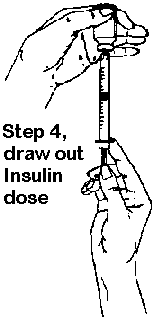 Turn
vial upside down, insuring that the tip of the needle is covered by the
insulin, and draw in to the syringe a bit more than the desired dosage,
perhaps one or two units more Turn
vial upside down, insuring that the tip of the needle is covered by the
insulin, and draw in to the syringe a bit more than the desired dosage,
perhaps one or two units more |
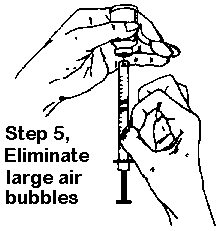 |
Carefully push the plunger in until the tip of the plunger is aligned
with the correct unit marking the the dosage desired.
The syringe is ready for use. If you are going to do a BG test (which I highly recommend you do before each injection, it would be wise to put the needle guard back on the syringe to keep it clean until you are ready for it. Note - as you replace the needle guard be very careful not to push the needle through the side of the needle guard. This is important for two reasons, 1) Doing so will dull the needle, 2) you might stick yourself in the finger with the needle if it goes through the side of the needle guard. There is little danger of your accidentally injecting yourself with insulin, as long as you do not touch the plunger But if you stick yourself, you'll be dulling the needle, contaminating it, and the needle prick will sting a bit. |
Diluting Insulin in order to accurately measure fractional unit doses
Because some cats get such small doses of insulin, it is some times helpful to dilute in order to more accurately measure out a dose. I dilute Simon's insulin for this reason.If you are using Lilly's Humulin Lente or Ultralente you use a product from Lilly called Diluent to dilute the insulin.
Diluent, along with a sterile mixing vial can be obtained by your vet or pharmacist free of charge from Lilly. Do not use anything else to dilute these insulins. Lilly says that it is okay, in an emergency, to dilute a single dose with saline, but at all other times all dilution should be done with Diluent.
Also DO NOT LET your vet charge you for the Diluent or the mixing vial. They can get it free from Lilly and there is absolutely no reason that you should have to pay for it!
You can have your vet do the mixing, but chances are they will want to charge you for it and the procedure is much simple to pay someone to do.
I will update this page within a few days to include the step by step procedure for diluting insulin to a specific dilution ratio.